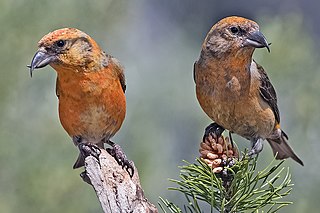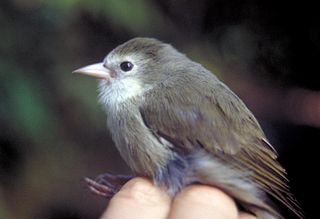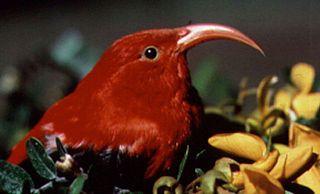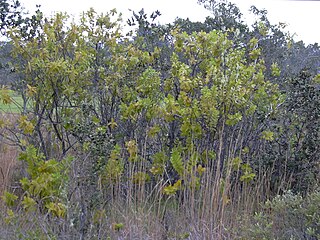
The true finches are small to medium-sized passerine birds in the family Fringillidae. Finches generally have stout conical bills adapted for eating seeds and nuts and often have colourful plumage. They occupy a great range of habitats where they are usually resident and do not migrate. They have a worldwide native distribution except for Australia and the polar regions. The family Fringillidae contains more than two hundred species divided into fifty genera. It includes the canaries, siskins, redpolls, serins, grosbeaks and euphonias, as well as the morphologically divergent Hawaiian honeycreepers.

The ʻiʻiwi or scarlet honeycreeper is a species of Hawaiian honeycreeper. The ʻiʻiwi is a highly recognizable symbol of Hawaiʻi. The ʻiʻiwi is one of the most common endemic birds of the Hawaiian Islands.
Located about 2300 miles (3680 km) from the nearest continental shore, the Hawaiian Islands are the most isolated group of islands on the planet. The plant and animal life of the Hawaiian archipelago is the result of early, very infrequent colonizations of arriving species and the slow evolution of those species—in isolation from the rest of the world's flora and fauna—over a period of at least 5 million years. As a consequence, Hawai'i is home to a large number of endemic species. The radiation of species described by Charles Darwin in the Galapagos Islands which was critical to the formulation of his theory of evolution is far exceeded in the more isolated Hawaiian Islands.

The poʻo-uli or black-faced honeycreeper is an extinct species of passerine bird that was endemic to the island of Maui in Hawaiʻi. It is considered to be a member of the Hawaiian honeycreepers, and is the only member of its genus Melamprosops. It had a black head, brown upper parts and pale gray underparts. This bird inhabited only the wetter, easternmost side of Maui, where it had rapidly decreased in numbers. With extinction threatening, efforts were made to capture birds to enable them to breed in captivity. These efforts were unsuccessful; in 2004, only two known birds remained, and since then, no further birds have been sighted. A 2018 study recommended declaring the species extinct, citing bird population decline patterns and the lack of any confirmed sightings since 2004, and in 2019, the species was declared extinct.

Cytisine, also known as baptitoxine, cytisinicline, or sophorine, is an alkaloid that occurs naturally in several plant genera, such as Laburnum and Cytisus of the family Fabaceae. It has been used medically to help with smoking cessation. Although widely used for smoking cessation in Eastern Europe, cytisine remains relatively unknown beyond it. However, it has been found effective in several randomized clinical trials, including some in the United States and a large one in New Zealand, and is being investigated in additional trials in the United States and a non-inferiority trial in Australia in which it is being compared head-to-head with the smoking cessation aid varenicline. It has also been used entheogenically via mescalbeans by some Native American groups, historically in the Rio Grande Valley predating even peyote.

The cardueline finches are a subfamily, Carduelinae, one of three subfamilies of the finch family Fringillidae, the others being the Fringillinae and the Euphoniinae. The Hawaiian honeycreepers are now included in this subfamily. Except for the Hawaiian honeycreepers which underwent adaptive radiation in Hawaii and have evolved a broad range of diets, cardueline finches are specialised seed eaters, and unlike most passerine birds, they feed their young mostly on seeds, which are regurgitated. Besides this, they differ from the other finches in some minor details of their skull. They are adept at opening seeds and clinging to stems, unlike other granivorous birds, such as sparrows and buntings, which feed mostly on fallen seeds. Some members of this subfamily are further specialised to feed on a particular type of seed, such as cones in the case of crossbills. Carduelines forage in flocks throughout the year, rather than keeping territories, and males defend their females rather than a territory or nest.

Sophora chrysophylla, known as māmane in Hawaiian, is a species of flowering plant in the pea and bean family, Fabaceae, that is endemic to Hawaii. It is highly polymorphic, growing as a shrub or tree, and able to reach a height of 15 m (49 ft) in tree form. Yellow flowers are produced in winter and spring.

The palila is a critically endangered finch-billed species of Hawaiian honeycreeper. It has a golden-yellow head and breast, with a light belly, gray back, and greenish wings and tail. The bird has a close ecological relationship with the māmane tree, and became endangered due to destruction of the trees and accompanying dry forests. The first specimen of the palila was collected in 1876 at the Greenwell Ranch on the Big Island by Pierre Étienne Théodore Ballieu (1828–1885), who was French consul in Hawai‘i from 1869 to 1878. The type specimen is housed at the Muséum national d'histoire naturelle in Paris.

The Lānaʻi hookbill is an extinct species of Hawaiian honeycreeper. It was endemic to the island of Lānaʻi in Hawaiʻi, and was last seen in the southwestern part of the island. George C. Munro collected the only known specimen of this species in 1913, which is housed in the Bernice P. Bishop Museum in Honolulu, and saw the species only twice more, once in 1916 and for a final time in 1918. No other sightings have been reported. They inhabited montane dry forests dominated by ʻakoko and ōpuhe. The Lānaʻi hookbill was monotypic within the genus Dysmorodrepanis and had no known subspecies. Its closest relative is believed to be the ʻōʻū, and some early authors suggested that the Lānaʻi hookbill was merely a deformed ʻōʻū. The Lānaʻi hookbill was a plump, medium-sized bird with greenish olive upperparts and pale whitish yellow underparts. It also had a yellow or white superciliary line and a white chin and throat. The wings also had a distinctive and conspicuous white wing patch. The hookbill's distinguishing characteristic was its heavy, parrotlike bill, which had the mandibles hooking sharply towards each other, leaving a gap between them when the beak was closed.

The ʻakikiki, also called the Kauaʻi creeper, is a critically endangered Hawaiian honeycreeper endemic to Kauaʻi, Hawaiʻi. It is the only member of the genus Oreomystis. Of the Hawaiian birds known to be extant, it is thought to be the most endangered, with only 454 wild individuals known as of 2018. A survey report in 2021 estimated the population at 45 with a 5 percent annual decrease, and in July 2023 the remaining number of wild birds was estimated to be just 5 individuals. This species is predicted to be extinct in the wild in 2023.

The ʻākohekohe, or crested honeycreeper, is a species of Hawaiian honeycreeper. It is endemic to the island of Maui in Hawaiʻi. The ʻākohekohe is susceptible to mosquito‐transmitted avian malaria and only breeds in high‐elevation wet forests.

The greater koa finch is an extinct species of Hawaiian honeycreeper in the subfamily Carduelinae of the family Fringillidae. It was endemic to the island of Hawaiʻi.
The highland finch is an extinct member of the Fringillidae and a Hawaiian honeycreeper which is known only from a few bones found in caves. It is the only member of the genus Orthiospiza. It was endemic to the high-elevation areas of Mount Haleakalā on the Hawaiian island of Maui. It has been speculated that they were pushed to extinction because of habitat loss. It is known only from fossil remains and likely became extinct before the first Europeans arrived in 1778.
The Kauaʻi palila or Pila's palila is an extinct species of Hawaiian finch that was much larger than the palila. It was described from subfossil remains discovered at the Makauwahi Cave on the south coast of Kauai in the Hawaiian Islands.

The Laysan honeycreeper or Laysan ʻapapane is an extinct bird species that was endemic to the island of Laysan in the Northwestern Hawaiian Islands.

Hawaiian honeycreepers are a group of small birds endemic to Hawaiʻi. They are members of the finch family Fringillidae, closely related to the rosefinches (Carpodacus), but many species have evolved features unlike those present in any other finch. Their great morphological diversity is the result of adaptive radiation in an insular environment. Many have been driven to extinction since the first humans arrived in Hawaii, with extinctions increasing over the last 2 centuries following European discovery of the islands, with habitat destruction and especially invasive species being the main causes.

The Hawaiian tropical dry forests are a tropical dry broadleaf forest ecoregion in the Hawaiian Islands. They cover an area of 6,600 km2 (2,500 sq mi) on the leeward side of the main islands and the summits of Niʻihau and Kahoʻolawe. These forests are either seasonal or sclerophyllous. Annual rainfall is less than 127 cm (50 in) and may be as low as 25 cm (9.8 in); the rainy season lasts from November to March. Dominant tree species include koa, koaiʻa, ʻakoko, ʻōhiʻa lehua, lonomea, māmane, loulu, lama, olopua, wiliwili, and ʻiliahi. Endemic plant species in the dry forests include hau heleʻula, uhiuhi, and Gouania spp. The palila, a Hawaiian honeycreeper, is restricted to this type of habitat.

The Makauwahi Cave is the largest limestone cave found in Hawaii. It lies on the south coast of the island of Kauaʻi, in the Māhāʻulepū Valley close to Māhāʻulepū Beach, and is important for its paleoecological and archaeological values. It is reached via a sinkhole and has been described as “…maybe the richest fossil site in the Hawaiian Islands, perhaps in the entire Pacific Island region”.

Palila v. Hawaii Department of Land and Natural Resources was an ecological court case pertaining to the Palila and the Māmane-Naio ecosystem of Mauna Kea. The case stems from the introduction of goats and sheep onto Hawaiʻi island in the late 18th century, which became feral and damaged the local ecosystem. Before the 1920s elimination program was completed, it was replaced with a game control plan that caused controversy between hunters and conservationists. Claiming that the state of Hawaii was violating the Endangered Species Act, a suit was filed to the Ninth District Court; as a result, the state was ordered to eradicate all feral animals on the island within two years. A public hunting program was put in place and has been largely effective; the Palila has begun to recover, and the case demonstrated federal power to protect endangered species.
















